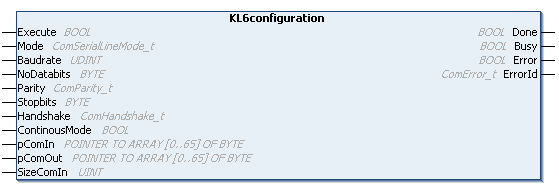KL6Configuration

The function block KL6Configuration initializes and configures a serial Bus Terminal KL6xxx.
The function block uses the standard register communication for KL Terminals for the configuration. For EtherCAT Terminals EL this register communication is not available. EL Terminals can be configured with function blocks from the EtherCAT library (FB_EcCoeSdoWrite).
 Inputs
Inputs
VAR_INPUT
Execute : BOOL;
Mode : ComSerialLineMode_t;
Baudrate : UDINT;
NoDatabits : BYTE;
Parity : ComParity_t;
Stopbits : BYTE;
Handshake : ComHandshake_t;
ContinousMode : BOOL;
pComIn : POINTER TO BYTE;
pComOut : POINTER TO BYTE;
SizeComIn : UINT
END_VARName | Type | Description |
|---|---|---|
Execute | BOOL | A rising edge at the Execute input resets the connected serial hardware. |
Mode | The Mode input specifies unambiguously which serial hardware is being used. | |
Baud rate | UDINT | The baud rate, provided it is supported by the serial hardware. |
NoDatabits | BYTE | The number of user data bits in one data byte. |
Parity | The type of the parity bit in a data byte. | |
Stop bits | BYTE | The number of stop bits per data byte. |
Handshake | The type of handshake used, provided it is supported by the serial hardware. | |
ContinousMode | BOOL | Switches on continuous transmission, provided this is supported by the serial hardware. If ContinousMode is TRUE, transmitted data is not sent out by the serial hardware until the hardware transmit buffer is full. This means that there are no time gaps in the transmission, provided the quantity of data is similar in size to the hardware transmit buffer. Continuous mode is only necessary in special cases in which the end device reacts to time gaps with a time-out. |
pComIn | POINTER TO BYTE | Universal pointer to the input variable of the process data for the serial hardware (data types: KL6inData, KL6inData5b, KL6inData22b, PcComInData). The pointer is assigned with the ADR() function. |
pComOut | POINTER TO BYTE | Universal pointer to the output variable of the process data for the serial hardware (data types: KL6outData, KL6outData5b, KL6outData22b, PcComOutData). The pointer is assigned with the ADR() function. |
SizeComIn | UINT | Size of the input process image of the serial hardware being used. The size is determined and assigned with the SIZEOF() function. |
 Outputs
Outputs
VAR_OUTPUT
Done : BOOL;
Busy : BOOL;
Error : BOOL;
ErrorID : ComError_t;
END_VARName | Type | Description |
|---|---|---|
Done | BOOL | The Done output becomes TRUE when the function has been carried out without error. |
Busy | BOOL | The Busy output becomes TRUE in response to rising edge at Execute, and remains TRUE for as long as the function block is performing its function. |
Error | BOOL | This output Error goes TRUE as soon as an error occurs. |
ErrorID | The ErrorID output provides an error code when an error occurs. |
Requirements
Development environment | Target platform | PLC libraries to include |
|---|---|---|
TwinCAT v3.1.4012 | PC or CX (x86, x64, Arm®) | Tc2_SerialCom |